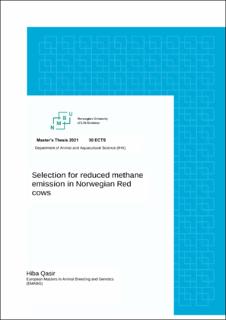| dc.description.abstract | Over the past years, methane production from dairy cattle gained a significant attraction because of its contribution to climate change and loss of dietary energy from the animals. This the first study to compare methane emission between high milk yielding (HL) and mastitis resistance (FL) lines of Norwegian Red cows, in level and development through lactation. The study also focussed on estimating the effects of genetic group, parity, lactation stage and calving season on methane emission. The data consisted of 5,012 observations of methane production measured with Greenfeed system from a herd of 47 Norwegian Red cows at the Center for Animal Experiments (SHF), NMBU. The data were analyzed using R software and least square means were calculated for methane production. The average methane production was 441g/d ranging from 115g/d to 497g/d. Overall, the average methane production was higher for HL in comparison to FL.
The analysis of methane production showed that the effect of genetic group on methane emission was not significant (p-value: 0.802993), whereas lactation number, calving month- year, lactation week and group * lactation number all had a significant effect (p-value <0.005). The difference in methane production between two groups was significant, indicating that indirect selection for high milk yield or mastitis resistance affects the methane production in these cows. The pairwise differences showed non-significant differences between the lactation weeks except for week 11. Cows in lactation 2 produced the highest methane (461g/d), and those in lactation 1 emitted the least amount (400g/d). There was a significant difference in methane emissions between lactation 1 and 2, and lactation 1 and 3 (p-value < 0.0001), however the difference was insignificant between lactation 2 and 3 (p-value: 0.4146). Cows calving in autumn months (September to November) produced more methane than those in winter months (December and January). There was a statistically significant difference between autumn months and winter months (p-value <0.05), however within months difference was insignificant (p-value >0.05). It is concluded that selection for mastitis resistance or milk yield provides basis for indirect selection for methane reduction, however, further experiments are required for building a solid conclusion. | en_US |

